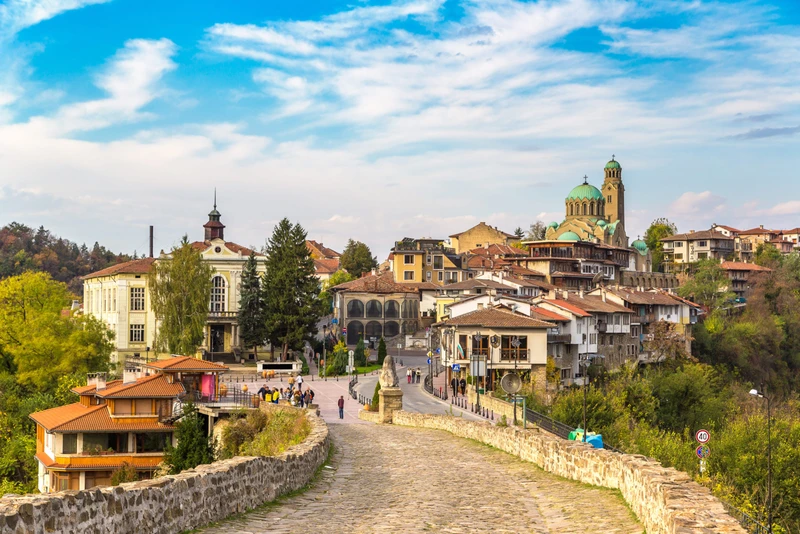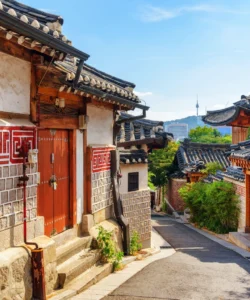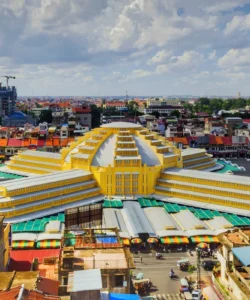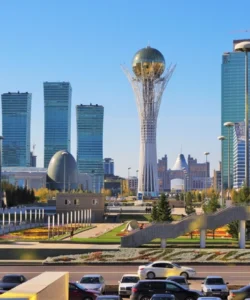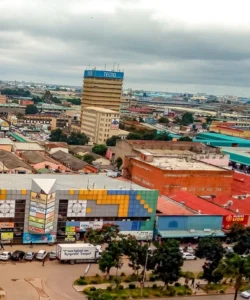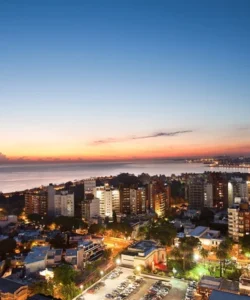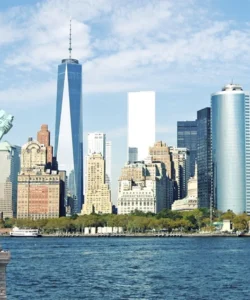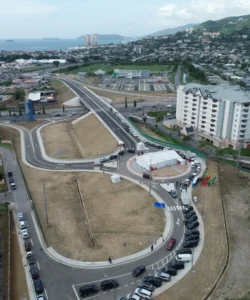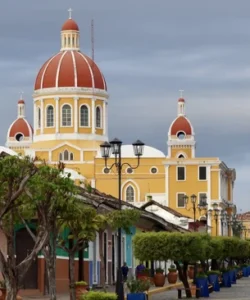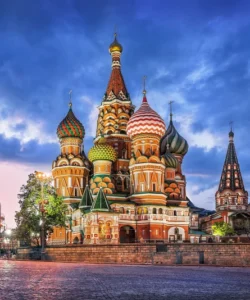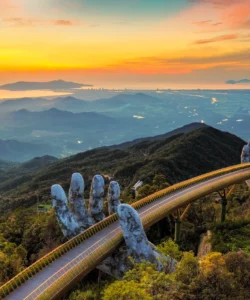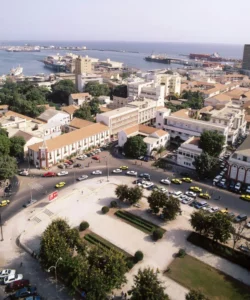Bulgaria, officially the Republic of Bulgaria, is a country in Southeast Europe. It is situated in the heart of the Balkans, bordering Romania to the north, Serbia and North Macedonia to the west, Greece and Turkey to the south, and the Black Sea to the east. Bulgaria is known for its diverse landscapes, including mountains, Black Sea coastlines, and fertile plains, as well as its rich history, ancient Thracian and Roman heritage, and vibrant folk traditions.
Listen to an introduction about Bulgaria
![]()
Area: Approximately 110,994 square kilometers (42,855 sq mi).
Population: As of 2023, the population is estimated at around 6.7 million.
Language: The official language is Bulgarian, a South Slavic language written in the Cyrillic alphabet. English is increasingly understood, especially by younger generations and in urban and tourist areas. Russian is also understood by some, particularly the older generation.
Currency: The official currency is the Bulgarian Lev (BGN). Although a member of the European Union, Bulgaria has not adopted the Euro. The Lev is pegged to the Euro at a fixed exchange rate (1 EUR = 1.95583 BGN).
Religion: The predominant religion in Bulgaria is Eastern Orthodoxy, primarily adherents of the Bulgarian Orthodox Church. There is also a significant Muslim minority, as well as smaller communities of other Christian denominations, Jews, and other faiths.
Capital: Sofia is the capital and largest city of Bulgaria. It is a vibrant city with a rich history, blending Roman ruins, Ottoman mosques, and Soviet-era monuments with modern developments.
Major Cities: Besides Sofia, other significant cities include Plovdiv, Varna, Burgas, Ruse, and Stara Zagora.
Attractions & Wonders: Bulgaria offers a fascinating mix of ancient history, beautiful nature, and cultural sites:
- Sofia:
- Alexander Nevsky Cathedral: One of the largest Eastern Orthodox cathedrals in the world and a prominent symbol of Sofia.
- St. George Rotunda Church: The oldest building in Sofia, dating back to the 4th century Roman Serdica.
- Vitosha Mountain: A natural park on the outskirts of Sofia, popular for hiking, skiing, and panoramic views of the city.
- Boyana Church: A UNESCO World Heritage site known for its exquisite medieval frescoes.
- National Historical Museum: Houses a vast collection of artifacts tracing Bulgarian history.
- Roman Serdica Ruins: Visible underground in the city center, showcasing Sofia’s ancient past.
- Plovdiv: One of Europe’s oldest continuously inhabited cities, a European Capital of Culture in 2019.
- Roman Amphitheatre: A remarkably preserved ancient Roman theatre still used for events.
- Old Town: A charming area with colorful Revival-era houses, cobblestone streets, and museums.
- Kapana Creative District: A lively neighborhood with art galleries, workshops, cafes, and restaurants.
- Rila Monastery: A UNESCO World Heritage site, the largest and most famous Eastern Orthodox monastery in Bulgaria. Nestled in the Rila Mountains, it’s renowned for its stunning architecture, frescoes, and spiritual significance.
- Veliko Tarnovo: A historic city that was the capital of the Second Bulgarian Empire. Known for its dramatic setting on hills overlooking the Yantra River and the impressive Tsarevets Fortress.
- Black Sea Coast: Popular for summer holidays with sandy beaches and resorts.
- Varna: A major port city and seaside resort with a vibrant cultural scene and Roman Baths.
- Nessebar: A UNESCO World Heritage site, an ancient town on a peninsula, famous for its well-preserved medieval churches and wooden houses.
- Sozopol: Another charming ancient seaside town with a relaxed atmosphere.
- Thracian Tombs: Bulgaria has a rich Thracian heritage, with several impressive burial sites.
- Thracian Tomb of Kazanlak: A UNESCO World Heritage site, known for its well-preserved Hellenistic frescoes.
- Thracian Tomb of Sveshtari: A UNESCO World Heritage site with unique half-human, half-plant caryatids.
- Balkan Mountains (Stara Planina): A major mountain range running across Bulgaria, offering hiking, skiing, and picturesque villages.
- Seven Rila Lakes: A spectacular group of glacial lakes in the Rila Mountains, popular for hiking.
Architecture: Bulgarian architecture reflects its long and varied history, influenced by Thracian, Roman, Byzantine, Ottoman, and Revival-era styles:
- Thracian and Roman: Remains of tombs, amphitheatres, and fortifications.
- Early Christian and Byzantine: Early churches and monasteries.
- Medieval Bulgarian: Fortresses (e.g., Tsarevets), churches, and some monastic complexes, often with distinctive brick and stone patterns.
- Ottoman: Mosques, baths, and characteristic Ottoman-era houses, particularly in old town centers.
- Bulgarian National Revival (18th-19th centuries): A unique architectural style characterized by large, multi-story houses with bay windows, colorful facades, and often elaborate interior carvings (e.g., Plovdiv’s Old Town, Koprivshtitsa).
- Socialist Realism: Prominent in post-WWII public buildings, monuments, and residential complexes in major cities, reflecting the Soviet era.
- Contemporary: Modern Bulgarian architecture incorporates new materials and designs, particularly in new commercial and residential developments.
Roads: Bulgaria has a developing road network. Major motorways (A-roads) connect key cities and regions (e.g., Sofia-Burgas, Sofia-Plovdiv, Sofia-Varna), and these are generally in good condition. However, secondary roads, especially in rural areas, can vary significantly in quality, with some being unpaved or poorly maintained. Significant investments are being made to improve infrastructure. A vignette (road tax sticker) is required for most roads.
Hotels: Bulgaria offers a wide range of accommodation options. In major cities like Sofia and Plovdiv, you’ll find international hotel chains, boutique hotels, and budget-friendly hostels. Along the Black Sea Coast, there are numerous resorts, from large all-inclusive hotels to smaller family-run guesthouses. In mountain areas, there are ski resorts with hotels and traditional mountain chalets. Throughout the country, you can also find charming guesthouses, rural farm stays, and spa hotels.
Restaurants: Bulgarian cuisine is hearty, flavorful, and diverse, with strong influences from Balkan, Ottoman, Greek, and Slavic culinary traditions. It features fresh vegetables, yogurt, cheese, grilled meats, and a variety of spices.
- Traditional Bulgarian Dishes:
- Shopska Salata (Шопска салата): The national salad, made with diced tomatoes, cucumbers, peppers, onions, and topped with grated white brined cheese (sirene).
- Banitsa (Баница): A traditional pastry made with layers of filo dough, eggs, and sirene cheese, often eaten for breakfast.
- Kebapche (Кебапче) and Kyufte (Кюфте): Grilled minced meat rolls (kebapche) and meatballs (kyufte), very popular and usually served with fries or shopska salata.
- Tarator (Таратор): A refreshing cold cucumber and yogurt soup, flavored with dill, garlic, and walnuts, popular in summer.
- Meshana Skara (Мешана скара): A mixed grilled platter featuring various meats.
- Musaka (Мусака): A baked dish with layers of minced meat, potatoes, and sometimes other vegetables, topped with a creamy yogurt-based sauce.
- Lukanka and Sudzhuk: Dry-cured spicy sausages.
- Rakia (Ракия): A strong fruit brandy, the traditional spirit of Bulgaria.
- Ayran (Айрян): A refreshing yogurt drink.
- Yogurt (Kiselo Mlyako): Bulgarian yogurt is renowned worldwide for its unique bacteria (Lactobacillus bulgaricus) and creamy texture.
- Wine: Bulgaria has a long history of wine production, particularly red wines.
- Grilled meats and vegetables are very popular.
- Bakeries (furni) offer a variety of fresh bread and pastries.
